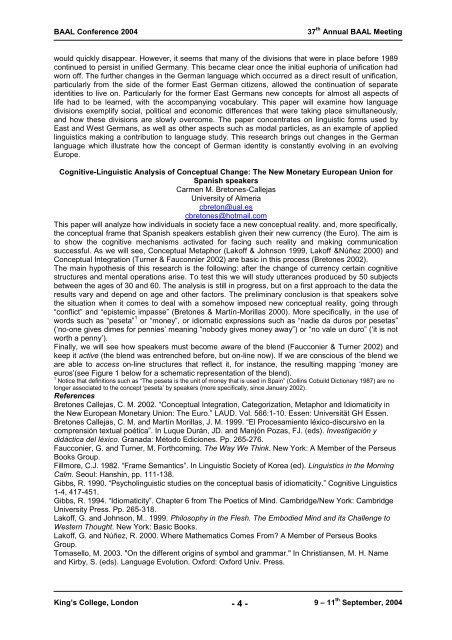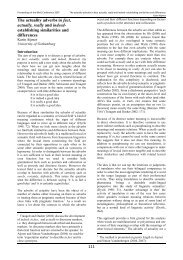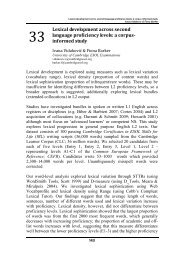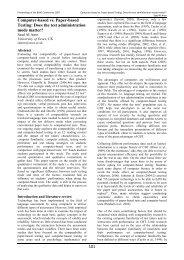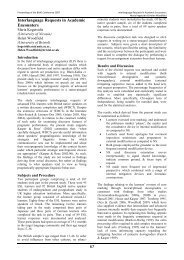Colloquia - British Association for Applied Linguistics
Colloquia - British Association for Applied Linguistics
Colloquia - British Association for Applied Linguistics
You also want an ePaper? Increase the reach of your titles
YUMPU automatically turns print PDFs into web optimized ePapers that Google loves.
BAAL Conference 2004 37 th Annual BAAL Meeting<br />
would quickly disappear. However, it seems that many of the divisions that were in place be<strong>for</strong>e 1989<br />
continued to persist in unified Germany. This became clear once the initial euphoria of unification had<br />
worn off. The further changes in the German language which occurred as a direct result of unification,<br />
particularly from the side of the <strong>for</strong>mer East German citizens, allowed the continuation of separate<br />
identities to live on. Particularly <strong>for</strong> the <strong>for</strong>mer East Germans new concepts <strong>for</strong> almost all aspects of<br />
life had to be learned, with the accompanying vocabulary. This paper will examine how language<br />
divisions exemplify social, political and economic differences that were taking place simultaneously,<br />
and how these divisions are slowly overcome. The paper concentrates on linguistic <strong>for</strong>ms used by<br />
East and West Germans, as well as other aspects such as modal particles, as an example of applied<br />
linguistics making a contribution to language study. This research brings out changes in the German<br />
language which illustrate how the concept of German identity is constantly evolving in an evolving<br />
Europe.<br />
Cognitive-Linguistic Analysis of Conceptual Change: The New Monetary European Union <strong>for</strong><br />
Spanish speakers<br />
Carmen M. Bretones-Callejas<br />
University of Almeria<br />
cbreton@ual.es<br />
cbretones@hotmail.com<br />
This paper will analyze how individuals in society face a new conceptual reality. and, more specifically,<br />
the conceptual frame that Spanish speakers establish given their new currency (the Euro). The aim is<br />
to show the cognitive mechanisms activated <strong>for</strong> facing such reality and making communication<br />
successful. As we will see, Conceptual Metaphor (Lakoff & Johnson 1999, Lakoff &Núñez 2000) and<br />
Conceptual Integration (Turner & Fauconnier 2002) are basic in this process (Bretones 2002).<br />
The main hypothesis of this research is the following: after the change of currency certain cognitive<br />
structures and mental operations arise. To test this we will study utterances produced by 50 subjects<br />
between the ages of 30 and 60. The analysis is still in progress, but on a first approach to the data the<br />
results vary and depend on age and other factors. The preliminary conclusion is that speakers solve<br />
the situation when it comes to deal with a somehow imposed new conceptual reality, going through<br />
“conflict” and “epistemic impasse” (Bretones & Martín-Morillas 2000). More specifically, in the use of<br />
words such as “peseta” 1 or “money”, or idiomatic expressions such as “nadie da duros por pesetas”<br />
(„no-one gives dimes <strong>for</strong> pennies‟ meaning “nobody gives money away”) or “no vale un duro” („it is not<br />
worth a penny‟).<br />
Finally, we will see how speakers must become aware of the blend (Faucconier & Turner 2002) and<br />
keep it active (the blend was entrenched be<strong>for</strong>e, but on-line now). If we are conscious of the blend we<br />
are able to access on-line structures that reflect it, <strong>for</strong> instance, the resulting mapping „money are<br />
euros‟(see Figure 1 below <strong>for</strong> a schematic representation of the blend).<br />
1 Notice that definitions such as “The peseta is the unit of money that is used in Spain” (Collins Cobuild Dictionary 1987) are no<br />
longer associated to the concept „peseta‟ by speakers (more specifically, since January 2002).<br />
References<br />
Bretones Callejas, C. M. 2002. “Conceptual Integration, Categorization, Metaphor and Idiomaticity in<br />
the New European Monetary Union: The Euro.” LAUD. Vol. 566:1-10. Essen: Universität GH Essen.<br />
Bretones Callejas, C. M. and Martín Morillas, J. M. 1999. “El Procesamiento léxico-discursivo en la<br />
comprensión textual poética”. In Luque Durán, JD. and Manjón Pozas, FJ. (eds). Investigación y<br />
didáctica del léxico. Granada: Método Ediciones. Pp. 265-276.<br />
Faucconier, G. and Turner, M. Forthcoming. The Way We Think. New York: A Member of the Perseus<br />
Books Group.<br />
Fillmore, C.J. 1982. “Frame Semantics”. In Linguistic Society of Korea (ed). <strong>Linguistics</strong> in the Morning<br />
Calm. Seoul: Hanshin, pp. 111-138.<br />
Gibbs, R. 1990. “Psycholinguistic studies on the conceptual basis of idiomaticity.” Cognitive <strong>Linguistics</strong><br />
1-4, 417-451.<br />
Gibbs, R. 1994. “Idiomaticity”. Chapter 6 from The Poetics of Mind. Cambridge/New York: Cambridge<br />
University Press. Pp. 265-318.<br />
Lakoff, G. and Johnson, M.. 1999. Philosophy in the Flesh. The Embodied Mind and its Challenge to<br />
Western Thought. New York: Basic Books.<br />
Lakoff, G. and Núñez, R. 2000. Where Mathematics Comes From? A Member of Perseus Books<br />
Group.<br />
Tomasello, M. 2003. "On the different origins of symbol and grammar." In Christiansen, M. H. Name<br />
and Kirby, S. (eds). Language Evolution. Ox<strong>for</strong>d: Ox<strong>for</strong>d Univ. Press.<br />
King‟s College, London 9 – 11 th - 4 -<br />
September, 2004


